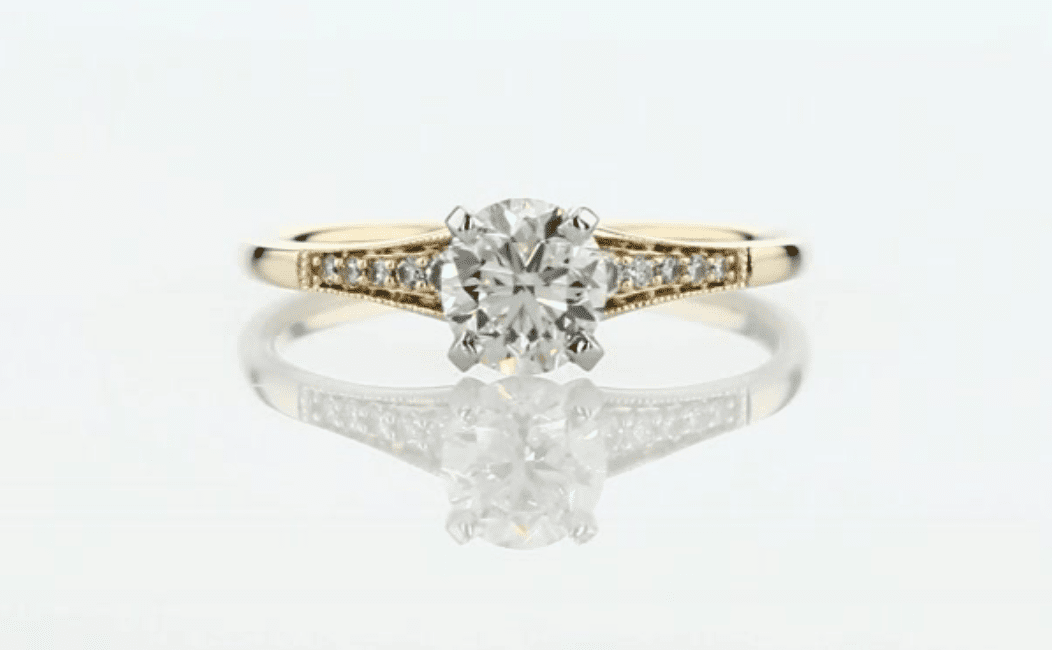The GIA Diamond Cut Grading System
How does the GIA diamond cut grading system work? Our guide will explain what the grades mean and how gemologists evaluate round brilliant diamond cuts.
3 Minute Read
A Brief History of GIA Cut Grading Systems
In the 1950s, the GIA established a system for grading diamonds based on the Four Cs — color, clarity, cut, and carat, which proved to be a great asset to the diamond industry. This system greatly improved the standards for evaluating color and clarity. However, the standards for evaluating the cut left something to be desired. To be fair, establishing a simple and usable system that would cover all the variables involved in the cut was very challenging.
The 2005 GIA diamond cut grading system finally accomplished this. Rather than placing cuts into four classes by calculating how close a cut stone came to an ideal set of proportions, the new system evaluates how the individual elements of the cut combine to affect the appearance of the diamond. There are now five grades, which indicate how well the cut affects a stone's performance. In addition, the GIA allowed some flexibility in the system for personal preferences. Table size is a prime example of this.
Interested in this topic?
This article is also a part of our Diamond Specialist Certification Course, in the unit Grading Diamonds.
What are the 2005 GIA Diamond Cut Grades?
The GIA assigns the cut of a diamond one of the following grades:
- Excellent (the best grade)
- Very Good
- Good
- Fair
- Poor (the worst grade)
The following details will help you understand the GIA's diamond cut grading system and what distinguishes, for example, an "Excellent" from a "Good" or "Fair" cut.
Excellent (EX)
An Excellent grade diamond has high brilliance, scintillation, and an even pattern of light and dark areas.
Very Good (VG)
Diamonds with this cut grade also have high brilliance and scintillation, but expect them to be a bit darker in the center or around the edges. In some cases, a diamond can have top brilliance and scintillation but still receive a lower grade due to its pattern. The stone above has a splintery pattern that prevents it from receiving an Excellent grade.
Good (G)
Generally, stones with this grade will be a bit darker or lacking in scintillation. The stone above appears dark around its girdle. A stone can also be graded down by its pattern or its weight ratio. In other words, if it weighs more than an average gem of its diameter, it will be graded down one step.
Fair (F)
A stone in this category will have very little brilliance or scintillation. The stone pictured above has a very dark ring around the girdle and a dark table area.
Poor (P)
Diamonds in this category have very poor proportions and show very little brilliance or scintillation. Expect to see "nail heads" (a black center) and "fish eyes" (all brilliance washed out in the center).
Many stones with poor grades may have a decent appearance, but their weight ratio will lower their grade.
Evaluating the Components of the Cut
The 2005 GIA system is based on seven components. The first three are visual; the others physical.
Visual Criteria
- Scintillation The small areas of light in a polished diamond that flash on and off as the diamond, observer, or lighting moves. There are also negative scintillation effects, which include windowing, dark centers, and dark upper girdles.
- Pattern The arrangement of light and dark areas that results from internal and external reflections.
- Contrast The relief of light and dark areas that creates the face-up pattern of a diamond.
Physical Components
- Weight Ratio A comparison of a diamond's weight to its diameter.
- Durability This covers thin girdles as well as inclusions that weaken a gem.
- Polish The overall quality of the stone's polish as well as any scratches, nicks, chips, etc.
- Symmetry Refers to the outline of the stone, facet arrangement, pointing, and table and culet centering.
Additional Notes
Although inclusions (fractures and tiny mineral crystals trapped inside a stone) can affect brilliance, they don't fall under the criteria for cut grades. Instead, the stone's clarity grade addresses the impact of inclusions on a diamond's performance.
These cut grades only apply to round brilliant-cut diamonds — and only to colorless diamonds (those with color grades from D to Z). Fancy cuts, such as ovals, hearts, and emeralds, as well as fancy colored diamonds, are graded differently.
Donald Clark, CSM IMG
Donald Clark, CSM founded the International Gem Society in 1998. Donald started in the gem and jewelry industry in 1976. He received his formal gemology training from the Gemological Institute of America (GIA) and the American Society of Gemcutters (ASG). The letters “CSM” after his name stood for Certified Supreme Master Gemcutter, a designation of Wykoff’s ASG which has often been referred to as the doctorate of gem cutting. The American Society of Gemcutters only had 54 people reach this level. Along with dozens of articles for leading trade magazines, Donald authored the book “Modern Faceting, the Easy Way.”
Related Articles
Diamond Value, Price, and Jewelry Information
Is a VS1 Clarity Diamond a Good Buy?
Marquise-Cut Diamonds Buying Guide: Vintage & Modern
Old European Cut Diamonds: The Complete Guide
Latest Articles
800 Years of Mogok: A Celebration in Tenuous Times
What is the Average Gemstone Faceting Yield?
Pyroxmangite Value, Price, and Jewelry Information
How to Identify Emerald Simulants and Synthetics
Never Stop Learning
When you join the IGS community, you get trusted diamond & gemstone information when you need it.
Get Gemology Insights
Get started with the International Gem Society’s free guide to gemstone identification. Join our weekly newsletter & get a free copy of the Gem ID Checklist!
